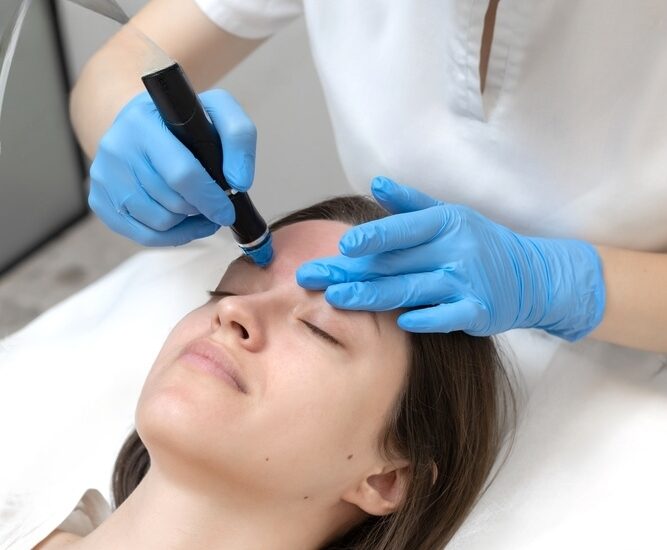A poorly designed tattoo can be a lifelong regret. Fortunately, advances in cosmetology have made it possible to safely and effectively remove unwanted tattoos. Despite common misconceptions, tattoo removal treatments have become increasingly reliable and secure, with minimal side effects. With the latest technology and expert care, you can now confidently erase your unwanted ink and start fresh.

Laser Tattoo Removal Treatment:
How it Removes The Tattoo:
Our Successful Results:

Top Benefits:
- Minimal Discomfort
- Effective Results
- Cost-Effective Solution
- Safe and Targeted Treatment
- Minimized Risk of Adverse Effects
- Improved Self-Confidence and Wellbeing
Who Can Be a Good Candidate:
- A person must be above 18 age.
- Both men and women are eligible.
- Those who want to remove unwanted tattoos.
- You must be free of every skin disease.
Before The Procedure:
- Nourishing Your Body for Optimal Healing
- Pre-Treatment Precautions: Avoid Shaving the Area
- Post-Treatment Care: Avoid Strenuous Exercise
- Pre-Treatment Precautions: Discontinue Blood-Thinning Medications
- Pre-Treatment Recommendations: Avoid Smoking and Alcohol Consumption
How It Will Perform:
1. Initial laser session: The practitioner will treat the tattooed area with the laser.
2. Follow-up sessions: Subsequent sessions are typically scheduled 5-8 weeks apart to allow for adequate healing time and to achieve gradual, consistent fading.
By following this treatment protocol, patients can expect remarkable results and a significant reduction in the appearance of their unwanted tattoo.
How Many Sessions are Required?
Laser tattoo removal is a non-invasive procedure that utilizes rapidly vibrating light beams to target and break up ink particles in the skin. This process, known as photothermolysis, causes the ink particles to shatter and disperse, allowing them to be gradually eliminated from the body through natural processes such as sweating and urination.
The duration and number of sessions required to completely remove a tattoo depend on various factors, including:
- Skin Tone:
- Location of Artwork:
- Surface Area:
1. Multiple treatment sessions, typically ranging from 15 to 20 or more
2. Extended treatment times, sometimes exceeding several hours per session
3. A prolonged overall treatment period, which can span several months to a year or more
It’s essential to consult with a qualified practitioner to discuss your specific needs and develop a personalized treatment plan. They will help you understand the process, timeline, and expected outcomes for your unique situation.
- Ink Colour
Notably, lighter ink colors, such as pastel shades or white ink, can be more challenging to remove completely. This is because lighter inks tend to be more resistant to laser treatment, requiring more intense and frequent sessions to break down the ink particles.
In contrast, darker ink colors, such as black or dark blue, are generally easier to remove, as they absorb the laser energy more readily. However, it’s essential to consult with a qualified practitioner to discuss your specific tattoo and develop a personalized treatment plan, as the removal process can vary significantly depending on individual factors.
Aftercare Instructions:
- After undergoing laser therapy to remove a tattoo, it's crucial to maintain good hygiene and keep the treated area clean and dry. This doesn't mean avoiding washing the area altogether; instead, gently pat the skin dry with a clean towel and lukewarm water.
- To promote healing and prevent complications after laser tattoo removal, it's essential to avoid soaking in water, especially bubble baths, for an extended period. Prolonged soaking can cause the treated skin to become bloated, allowing bacteria-containing water to penetrate the area and potentially leading to infections.
- After undergoing laser tattoo removal, it's essential to take extra precautions to protect your skin from the sun. Direct sunlight can cause severe blisters, sunburn, and other complications, which can hinder the healing process.
The Costs For Treatment:
The average cost Treatment in Islamabad, Rawalpindi, and Pakistan range between 10,000 PKR to 40,000 PKR. Also, there are a few factors that can affect the cost of the treatment. Such as
- The reputation of the clinic.
- The number of sessions.
- Type of treatment for large pores.
- Expert dermatologist’s fee.
Book Your Appointment With Us!

Understanding Acne: Causes, Treatments, and Prevention

Summer Skincare Tips: How to Beat the Heat

Hydrafacial for Acne-Prone Skin

Hair Transplant Techniques: FUE vs. FUT Explained

Understanding Alopecia: Types, Causes, and Treatment Options

Hydrafacial: The Ultimate Treatment for Healthy, Glowing Skin
The Importance of Regular Skin Check-Ups: Why Dr. Abbas Shah Recommends Them

Acne Treatment

Hydra Facial

Micro Hair Transplant

Alopecia

PRP Therapy

